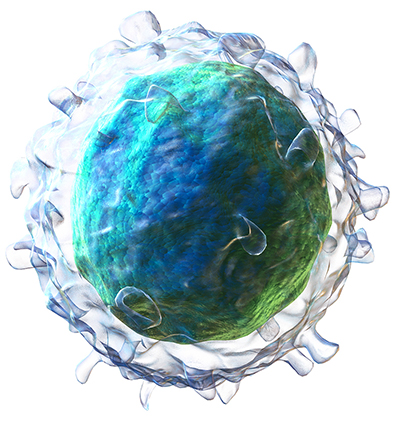By Cassandra Awgulewitsch

Kristy Stengel, a postdoc in the laboratory of Scott Hiebert (Biochemistry), led an investigation into the role of histone deacetylase 3 (HDAC3) in the formation of B cell germinal centers using a powerful combination of RNA-seq, ChIP-exome sequencing, and other technologies in human cell and mouse models. This work, published in Nucleic Acids Research, shows that HDAC3 plays a major role in determining B cell fate.
The adaptive immune system largely comprises B and T cells and is responsible for responding to pathogens. In particular, B cells make antibodies and mature in sites called germinal centers, transitioning from “dark zones” to “light zones” as the maturation progresses. In dark zones, B cells proliferate and undergo a process termed somatic hypermutation, which “trains” them to respond to pathogens they might encounter in the future. In the light zones they either become plasma cells, which produce many types of antibodies in response to antigens, or memory B cells, which produce only one type of antibody and are maintained long term in the event of future exposure to the same antigen. This maturation process is tightly controlled by a large number of transcription factors.
HDAC3 is part of a larger group of histone deacetylases (HDACs), enzymes with wide-ranging roles in cellular proliferation, angiogenesis, and cell differentiation, and which act by repressing gene transcription. Through a protein complex called NCOR1/SMRT, HDAC3 regulates key transcription factors that in turn regulate genes involved in the maturation of B cells. Knocking out Hdac3 leads to various levels of dysregulation depending on when and where during mouse development the knockout takes place.
For this reason, HDAC3 is of particular interest to researchers. The Hiebert lab examined how it directly affects the transcriptional program of B cells located in germinal centers. First, the group tested the effects of Hdac3 deletion on cell proliferation and plasma cell differentiation in a mouse spleen. Results showed that although proliferation was mostly unaffected, mice lacking Hdac3 had reduced numbers of plasma cells, indicating a differentiation impairment.
Through RNA-seq, an unbiased approach that shows total gene expression at certain snapshots in time, the group compared cells of germinal centers in spleens of Hdac3 knockout mice to normal control mice. The group noted that the mice’s expression profiles mirrored normal light zone gene expression: genes that were upregulated in the Hdac3 knockout mice are normally associated with light zones, and genes that were downregulated are also normally downregulated in the light zone. This finding suggests a link between HDAC3 and light zone formation in germinal centers.
Using a human cell line derived from germinal center cells and ChIP-exome sequencing, a technique that combines chromatin immunoprecipitation with sequencing to identify genes bound to a given target protein, the group determined that HDAC3 directly modulates genes driving the differentiation of plasma cells and that HDAC3 is necessary for the maturation of cells within the dark zone compartment of germinal centers. Hdac3 knockout mice showed a decreased number of cells within the dark zone with a corresponding increase in the number of cells within the light zone.
This paper implicates HDAC3 in the fate of B cells. While directly useful in understanding formation of light and dark zone formation – a critical component in the maturation of B cells – this work also has broader implications for the fields of immunology and cancer research.
HDAC inhibitors are increasingly used as anti-cancer therapies, and the FDA has approved them for use in lymphomas, cancers that arise within lymphocytes (B cells, T cells, and natural killer cells). As lymphoma is driven by ungoverned lymphocyte proliferation and differentiation into unwanted cell types, inhibiting these processes by targeting aberrant proliferation should stop or slow the progression of cancer. Targeted HDAC3 inhibition, either alone or with a combination of other therapies, might lead to decreased numbers of B cells by impairing their proliferation. Targeting the specific cell types that abnormally proliferate during lymphoma without affecting a wider range of critical cell types, as can be the case when using less targeted chemotherapies or radiation therapy of lymph nodes, might lead to faster and better clinical outcomes.
This research was funded by the T.J. Martell Foundation, the Robert J. Kleberg, Jr. and Helen C. Kleberg Foundation, the National Institutes of Health, the National Institute of Diabetes and Digestive and Kidney Diseases, the Vanderbilt Institute for Clinical and Translational Research, the Vanderbilt-Ingram Cancer Center, and the American Cancer Society.